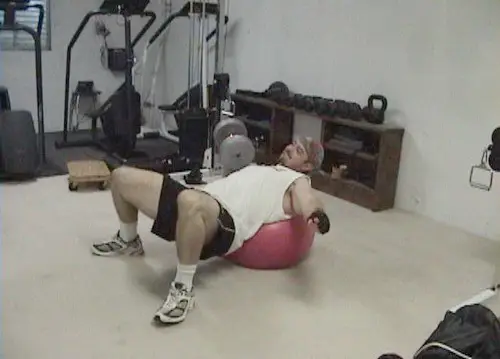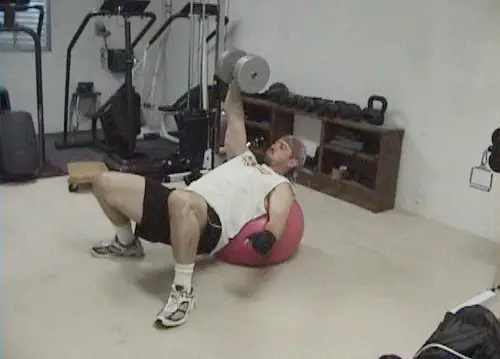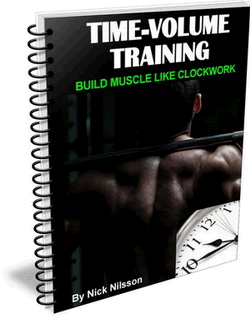By Nick Nilsson
Author of Muscle Explosion - 28 Days to Maximum Mass
So here's the deal...an injury isn't the end of the world. They happen to the best of us, sometimes no matter how careful you are.
And THAT is what this article is all about...I'm going to give you examples of how I'VE trained around a few injuries I've had over the 25+ years I've been training.

Getting these injuries didn't mean I had to completely stop every aspect of my training until I was fully recovered. In fact, continuing to train actually helped with recovery!
** Before we go any further, let me be VERY clear right up front.
The examples I'm using here are from MY own experience and used only on myself. I'm not recommending you do ANY of these techniques.
I'm not a doctor (and especially I'm not YOUR doctor). I'm not a physiotherapist. This should NOT be considered medical advice. When you read this article, PLEASE use your own common sense and PLEASE consult with your doctor and get the all-clear to train if you decide to train around any injury.
Injury #1 - Twisted Ankle
The first injury I want to talk about is a twisted ankle. I was playing soccer and got my foot stuck in a hole in the field and at the same moment got spun around by another player. So basically, I tore up most of the ligaments in my left ankle.
I did all the rest, ice, elevation, etc and I went to the doctor the next day. He told me I had two choices...because the sprain was so severe I could either put it in a cast and it would get weaker, or I could just keep icing and elevating it.
I asked him if I could do other things in the gym while it was healing and he not only said "absolutely," he actually encouraged me to start using it as soon as I felt I could put weight on it.
I was back in the gym that same evening, hobbling around and doing upper body training without any problems. The next day, I was doing one-legged squats on my RIGHT leg (the uninjured side).
By working the non-injured side, you can prevent a lot of the strength loss and atrophy that you often see when a limb is immobilized. This happens because of nervous system activation.
When the right leg is used and activated, the nervous system also activates the corresponding motor units of the OTHER side. This can help prevent a lot of the muscle-wasting you see with people who are in casts - if only they would have trained their uninjured side!
The key thing to note is that even though I was working my right leg, I wasn't putting pressure on my injured side while I still had pain on it. As it healed and I was able to put pressure on it without pain, then I gradually worked it back into my training, with no loss of performance.
Injury #2 - Wrist Pain
This happened to me my very first year of training and I very quickly figured out exactly what the cause was: too much barbell curling.
Every time I picked up the straight bar to do curls, I would get sharp pains in my wrists. I even got to the point where I got a couple of wrist wraps to help ease the pain (which worked briefly).
How did I train around that injury? Easy. Dumbbell Curls.
Once I figured it out, I immediately stopped all barbell training...curls, benching, rows, machines, everything that locked my wrists into position while training.
I still had some pain in my wrists while I was doing dumbbell work for several weeks after I got off barbells, but the wrist pain gradually went completely away on its own.
The key thing to note here - I had an injury as a result of getting "locked in" on barbells (especially straight barbell curls, which put a lot of pressure on the wrists, which in itself is the reason the EZ Curl bar was invested), and I immediately trained around that by switching to dumbbells.
Problem solved, and I actually saw increased growth and strength because I changed things up.
Injury #3 - Pulled Tricep Muscle
This one will seem like a strange injury...I pulled the long head of my left tricep doing heavy SHRUGS. Yep, you read that right. Shrugs.
The reason I pulled the long head is because it's the only head of the three-headed tricep muscle that crosses the shoulder joint. I had been doing high training volume (shrugs every session) and heavy weight (about 600 lbs) for a number of weeks and it caught up to me.
Because of the nature of the injury, it meant some changes to my program. It meant no more deadlifts, shrugs or stiff-legged deadlifts. Also, I was off all rowing, chinning and pull-down movements. Ironically enough, I could actually do close-grip bench pressing and dips without any problem at all, which is strange for a tricep injury.
My tricep was injured but I could hardly do any BACK training because of it.
Training around it was relatively simple. I just avoided those exercises I mentioned. But that left me without many options for back training. For back, I used a bench press machine backwards, sitting with my chest towards the back pad. I then put my elbows against the bench handles and pushed back against them to get the back activated. This took the injured tricep completely out of the movement but allowed me to get in some decent back training.
Injury #4 - Strained Pectoral Muscle
This one happened to me doing VERY heavy weighted dips. I had 170 lbs hanging off my waist, had just done several sets with that weight and decided to finish with some high-rep, top-range partials to really overload the muscle.
It's a technique I'll never use again, because looking back on it, I was totally setting myself up for this injury. Very heavy weight on a stretch-focused exercise (which in and of itself wasn't so bad) but then when I did the high-rep partials, it was like tearing the muscle repeatedly until it ripped even more.
The good thing is, the moment I felt the start of the strain, I dropped to the ground immediately, so I didn't get an actual muscle tear, thought I thought was pretty much done with chest training for at least a month.
Not even close...after swearing about it for awhile, I began doing one-arm dumbbell bench press (on the Swiss ball) on my right side to help keep the strength up on both sides.


I avoided all exercises that caused any pain or stretch on the left pec (to give you an idea, I couldn't bench press even a 10 lb dumbbell without pain on that side).
I kept up with the one-side pressing and within a month, I was back pressing 100 lb dumbbells with both sides with no pain and no real loss of strength in the injured side.
The key here is that I focused on what I COULD do and not what I couldn't. This allowed me to keep up with regular training and not see any drop in strength or mass, even on the injured side.
Injury #5 - Pulled Muscle in my Lower Back
This one I wanted to use as an example of an injury that I COULDN'T train around. I did this one to myself trying to stretch out my lower back with a twisting stretch. BAD idea. I was about do some incline barbell bench and I was sitting on the bench, rotating my torso and pushing with my right elbow against the outside of my left knee.
And then I felt and heard a "POP."
And that was that. I was doubled over on the floor and could hardly breathe. No workout that day.
It took me about 4 times as long to walk home because I could hardly hold myself upright. Sleeping was no fun at all. Luckily at that point, I still owned a weight belt. I had to wrap it tight around myself and sleep with it on in order to not be in excruciating pain.
There was simply NO way for me to train around that one. Breathing, let alone training, was painful. I couldn't support any weight. To this day, when I get lean enough, I can still see where the muscle popped through the fascia in my lower back.
A few days later, I was able to get back in the gym and do some light training but that was definitely something not to be trained around.
Conclusion:
The key to remember here is to pick your battles. I've had injuries I could easily train around and which were more inconvenience than injury. I've also had injuries where discretion is the better part of valor and have had to take time off.
In all things, if YOU decide you want to try and train around an injury, PLEASE check with your doctor first. The last thing you want to happen is to self-diagnose and find out later there was more going on with the injured area than you thought.
Yeah, it stinks to have to take time off training, but the alternative could be a MUCH longer recovery time or even chronic re-injury and weakness.
Got Nagging Elbow Pain? Fix it FAST...
 Learn how to fix it with the book "Fixing Elbow Pain" by my colleagues Rick Kaselj and Jedd Johnson. This book is packed with useful, practical information you can use to naturally heal your elbow pain.
Learn how to fix it with the book "Fixing Elbow Pain" by my colleagues Rick Kaselj and Jedd Johnson. This book is packed with useful, practical information you can use to naturally heal your elbow pain.
![]()
More From Fitstep.com
| How to Do Your First Chin-Up | |
| 3 Things People Do To Totally Screw Up Their Fat Loss | |
| 7 Simple Rules for What You Should Eat | |
| Build Monster Calves With Lengthwise Barbell Donkey Calf Raises |
Share This Page...
---
Home -> Muscle and Strength -> Tips and Articles -> Train Around Injuries



